Nobody ever told me that becoming a marine biologist would involve spending four years figuring out how to count. Because, seriously, how hard can counting be? Well, it turns out, when you’re trying to count tiny pieces of plastic in the ocean, it gets complicated really fast.
When I went out to the North Pacific Subtropical Gyre in 2009 and 2010, part of the goal was to figure out how much plastic debris was actually there. That’s the first step to understanding what impact it might be having the ecosystem, after all. So we towed a net around on the surface, and towed a net underwater, and made visual counts of the plastic floating by on the ocean’s surface. Between the two cruises, we had measurements of plastic quantity over 6,000 miles of ocean – we were all set, right?
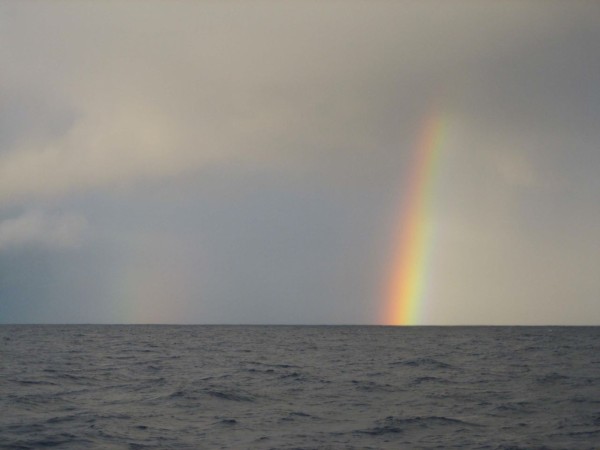
But when we started to analyze the data, things got complicated. The quantity of trash was hugely variable. Tows taken right next to each other, or taken in around the same location a year apart, had very different quantities of plastic. In order to get a handle on why this was, I teamed up with Andrew Titmus, an ornithologist who did the visual counts of floating plastic on our 2009 cruise, and Mike Ford, a NOAA oceanographer who was Chief Scientist on the 2010 cruise. The results were published in PLOS ONE last week, and NOAA has a brief writeup here.
The paper was hard to write, because it’s essentially “here’s a bunch of things that you should know about where plastic is in the quote-unquote garbage patch,” or, as I very scientifically referred to it on Twitter, a giant BLORT of data. I’m going to highlight a couple major points, but feel free to check out the paper yourself and ask more questions below.
1. Wind matters.
When the ocean is really calm, the plastic bobs to the surface and there’s a lot of it. When the wind kicks up and the ocean gets choppy, the plastic gets mixed below the surface, and you can’t capture it in a surface-towed net (which is the standard way to measure plastic). Our plastic counts go way down once the wind gets to a certain point, regardless of where we are in the ocean. Giora Proskurowski & colleagues found a similar phenomenom in the Atlantic.

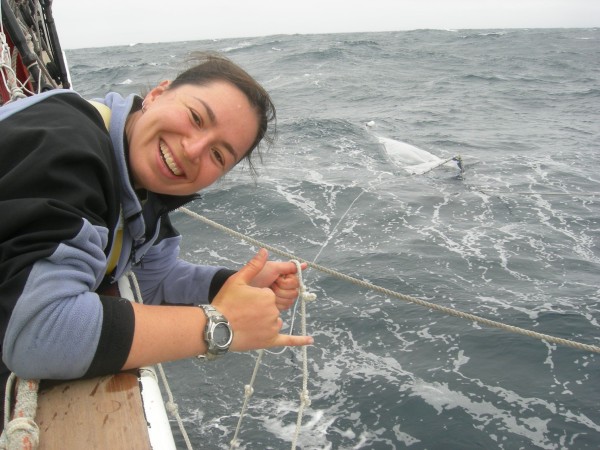
2. Filtering tiny amounts of plastic out of the ocean takes out a lot of life, too.
For every 1000 grams (2 lbs) of plastic bits we removed from the water, we took out 731 grams (1.6 lbs) of ocean life, primarily zooplankton and baby fish. That’s a lot of critters, particularly since life is relatively sparse in the North Pacific Gyre. Remediation schemes will have to be sure that they are not causing more damage than they’re solving. For more on that, check out the Open Ocean Cleanup Guidelines.
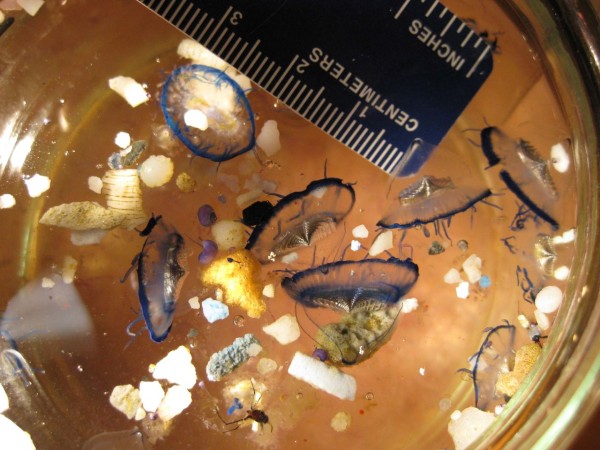
3. Since plastic varies so much, it’s going to take a lot of work to figure out whether it’s increasing or decreasing.
We used our data to create an imaginary future where plastic had increased between 10% and 100%. It turns out that it’s really hard to detect even relatively large increases in plastic with reasonable certainty. On the 2009 cruise, we worked our butts off for three weeks to take 119 surface samples (and it took me over a year, a lot of bad R code, and the help of awesome volunteers to convert jars of plankton and plastic into data). Unfortunately, it would take 250 surface samples to detect a 50% increase in microplastic with 80% probability. We’re going to have to figure out a better way to do that, or we won’t be able to tell if the problem is getting better, or getting worse.

So, what’s the take-home of this paper? We can’t go waltzing into the Gyre wanting to do everything at once (like I did in 2009 *cough cough*). To be effective, expeditions on the science of plastic debris need to think about what their specific objectives are. Want to study the animals growing right on the plastic? Target the rarer large floating objects. Want to get a glimpse of how the widest array of ocean life is interacting with plastic? Seek out trash stuck in eddies, where temporary pulses of high-nutrient water cause plankton to grow and attract fish.
If you want more, data from this paper is archived online at the CCE LTER Datazoo, and figures that didn’t quite fit into the paper, such as the types of plastic we collected, can be found over on Figshare. Want to know more about what all this plastic is doing to marine life? Check out Chelsea’s guest post and new paper on what happens when fish eat plastic, and Mark Browne’s new paper (with BBC article!) on lugworms. And as always, I’m happy to answer your questions in the comment thread.

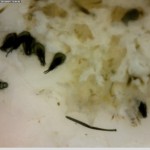
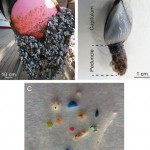
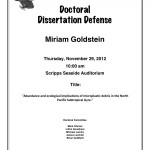
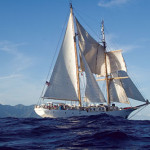
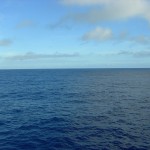
Thanks for these posts on plastic debris. It’s an issue I am interested in and I look forward to more posts on the subject.
Miriam,
OK, you wrote a lot. But, you did not really tell me much …. So, I will point out what I felt as I read your blog. And then I will mention what I ‘noticed.’
Your blog post read like you were trying to just ‘kick the ball down the road.’
I appreciate your honesty about the topic. Plastic in the ocean is not at the top of my list of priorities, but I do not think we need to pollute just because we can.
So, I would like to point out one observation I made about your data.
There is about as much surface plastic in the gyre as there is marine life …. 50% life and 50% plastic does not sound good to me.
Thank you,
Wayne
luvsiesous.com
So filtering my morning coffee is possible, sucking up oil infused water and separating the two is possible, and of course any attempt to remove the plastic will kill sea life but the plastic itself is killing sea life.
Really, you have a problem with this article. Either is is possible and should be done. It is possible and shouldn’t for a valid reason or it’s not possible.
We know it Is possible and that tis far, far better to remove it then let it stay.
Glad you find them useful!
One blog post can’t do everything! This particular post was about how to measure the amount of plastic in the ocean. I’ve written extensively about the “not good” parts elsewhere – see here, here, here, and Chelsea Rochman’s guest post here.
It’s a pretty big deal to kill most of the sea life on the ocean’s surface! We need to be really, really sure that removing the plastic is the right solution before spending billions of dollars to essentially clear-cut the surface of the large swaths of the ocean. That evidence is not there yet.
Miriam, Great Data! The problem as I see it is how to sort the microlife from the microplastic. Optical sorting systems could be modified for this purpose, They are in use for sorting seeds about the same size as the plankton in the picture. Thanks for the work you are doing!
I’ve always wondered why there hasn’t been a widespread effort to remove the garbage patch, and now I know. Thank you. Looking forward to learning more, hopefully a solution can be found that minimizes loss of life.
I would think sea life would eventually replace itself (multiply = good thing), but the plastic will also just keep multiplying = bad thing. I vote to clean up the existing plastic and let nature take it’s course with the sea life. Maybe harvest some of the rare species and replace them to the ocean after cleanup? I’m just a knucklehead living by the ocean in Florida but I do care about our oceans and the world beneath the water’s surface.
Oh, man, automatic sorting of plankton samples would be amazing (this would only work for dead, preserved plankton – there’s no way live plankton would be viable after sorting). It took a minimum of 2 hours per sample (often more like 4) to sort the plastic out under the microscope. Automated sorting could increase the sample size wonderfully.
Kerra – You might also be interested in the Ocean Cleanup Guidelines that I wrote with John Davis.
The North Pacific Gyre is more than twice the size of the continental United States. Even if it were technically feasible to filter out plastic (which is really isn’t), sea life could not easily recover from being removed from an area that vast. We also don’t know how to keep most open-ocean species alive in captivity – since they live in an environment without any walls or floors, they tend to bash themselves to death on the sides of the tank.
If only there was a way to take advantage of the fact that many of the common plastics will hold a static charge and use that for filtering but alas electrostatics and water don’t mix.
hi
Please have a look at the work of Boyan Slat
http://www.boyanslat.com/plastic5/
Kim Martini and I have, and we don’t think it’s feasible. Also please see the Ocean Cleanup Guidelines that address some of the same issues.
It seems to me that the larger pieces of plastics are deadly. That said, how much damage to the micro-pieces do? They seem to be small enough to pass through the digestive tracts of the animals that we typically worry about.
I don’t know if it’s worthwhile spending resources and damaging other sea life in saving a certain percentage of microfauna – just so long as the species aren’t in danger.
Would the money be better spent ridding the ocean of larger pieces, and trying to curtail the dumping of more?
Hi Miriam, is there any data available on the size distribution for larger objects?
And if this has not been studied during your expeditions, are you perhaps aware of another paper on this?
Thank you.
when you conduct a troll picking up +/- 50% sea life or plastic you have removed a finite amount of plastic and made the ocean cleaner. the sea life will repopulate and the plastic will dilute in the whole. eventually a troll will produce less plastic relative to sea life and become less efficient, but by that time you will have removed mountains of plastic. that is worth the effort…find a way to mine those mountains for profit and they may pay the way.
Certainly it’s my opinion, and that of many other folks that work on marine debris, that there’s no point in trying to clean plastic out of the ocean while we’re simultaneously dumping more in. We’re actually not very good at preventing plastic from going into the ocean in the first place.
See Figure 7 in our the paper for a size spectra of both microplastic and macroplastic based on cross-sectional area (though larger objects are placed into only 3 size classes). Another paper that looks at size-binned floating objects is Ryan 2013.
We have not stopped putting more plastic in the ocean – just go down to any river or beach after a big holiday weekend. There’s no point in a huge investment in cleanup & a lot of collateral environmental damage when more plastic is just getting dumped into the ocean.
I know that plankton vary in size and that they do not always hang around surface. You already know the best weather and sea conditions to skim. So maybe you can determine the best time to skim the surface for plastice the size above the average size plankton. You’ll be able to gather plastic and minimize the loss of plankton. What do you think?
There isn’t a way to avoid plankton – while there’s more plankton on the surface at night as compared to day, there isn’t a huge different in respect to plastic. This is shown in Fig 9. in the paper.